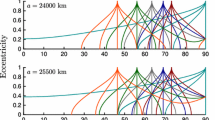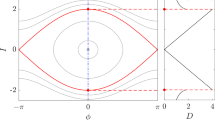Abstract
We explore the long-term stability of Earth Trojans by using a chaos indicator, the Frequency Map Analysis. We find that there is an extended stability region at low eccentricity and for inclinations lower than about \(50^{\circ }\) even if the most stable orbits are found at \(i \le 40^{\circ }\). This region is not limited in libration amplitude, contrary to what found for Trojan orbits around outer planets. We also investigate how the stability properties are affected by the tidal force of the Earth–Moon system and by the Yarkovsky force. The tidal field of the Earth–Moon system reduces the stability of the Earth Trojans at high inclinations while the Yarkovsky force, at least for bodies larger than 10 m in diameter, does not seem to strongly influence the long-term stability. Earth Trojan orbits with the lowest diffusion rate survive on timescales of the order of \(10^9\) years but their evolution is chaotic. Their behaviour is similar to that of Mars Trojans even if Earth Trojans appear to have shorter lifetimes.







Similar content being viewed by others
References
Bottke, W.F. Jr., Vokrouhlický, D., Rubincam, D.P., Broz, M.: The effect of Yarkovsky thermal forces on the dynamical evolution of asteroids and meteoroids. Asteroids III, 395–408 (2002)
Connors, M., Wiegert, P., Veillet, C.: Earth’s Trojan asteroid. Nature 475, 481–483 (2011)
\({\acute{\rm C}}\)uk, M., Hamilton, D., Holman, M.: Long-term stability of horseshoe orbits. MNRAS 426, 3051–3056 (2012)
Dvorak, R., Lhotka, C., Zhou, L.: The orbit of 2010 TK7: possible regions of stability for other Earth Trojan asteroids. Astron. Astrophys. 541, A127 (2012)
Érdi, B.: Long periodic perturbations of Trojan asteroids. Celes. Mech. 43, 303–308 (1987)
Laskar, J.: The chaotic motion of the solar system—a numerical estimate of the size of the chaotic zones. Icarus 88, 266–291 (1990)
Levison, H.F., Duncan, M.J.: The long-term dynamical behavior of short-period comets. Icarus 108, 18–36 (1994)
Mainzer, A., Grav, T., Masiero, J., Bauer, J., Cutri, R.M., McMillan, R.S., Nugent, C.R., Tholen, D., Walker, R., Wright, E.L.: Physical parameters of asteroids estimated from the WISE 3-band data and NEOWISE post-cryogenic survey. ApJL 760, L12 (2012)
Marzari, F., Tricarico, P., Scholl, H.: Saturn Trojans: stability regions in the phase space. ApJ 579, 905–913 (2002)
Marzari, F., Tricarico, P., Scholl, H.: Stability of Jupiter Trojans investigated using frequency map analysis: the MATROS project. MNRAS 345, 1091–1100 (2003)
Mikkola, S., Innanen, K.A.: Studies on solar system dynamics. II—the stability of earth’s Trojans. AJ 100, 290–293 (1990)
Milani, A.: The Trojan asteroid belt: proper elements, stability, chaos and families. Celes. Mech. Dyn. Astron. 57, 59–94 (1993)
Nesvorný, D., Morbidelli, A., Vokrouhlický, D., Bottke, W.F., Brož, M.: The flora family: a case of the dynamically dispersed collisional swarm? Icarus 157, 155–172 (2002)
Robutel, P., Gabern, F.: The resonant structure of Jupiter’s Trojan asteroids—I. Long-term stability and diffusion. MNRAS 372, 1463–1482 (2006)
Scholl, H., Marzari, F., Tricarico, P.: Dynamics of Mars Trojans. Icarus 175, 397–408 (2005)
Schwarz, R., Dvorak, R.: Trojan capture by terrestrial planets. Celes. Mech. Dyn. Astron. 113, 23–34 (2012)
Šidlichovský, M., Nesvorný, D.: Frequency modified Fourier transform and its applications to asteroids. Celes. Mech. Dyn. Astron. 65, 137–148 (1996)
Tabachnik, S.A., Evans, N.W.: Asteroids in the inner solar system—I. Existence. MNRAS 319, 63–79 (2000)
Acknowledgments
We thank Matija Ćuk and an anonymous referee for useful comments and suggestions.
Author information
Authors and Affiliations
Corresponding author
Rights and permissions
About this article
Cite this article
Marzari, F., Scholl, H. Long term stability of Earth Trojans. Celest Mech Dyn Astr 117, 91–100 (2013). https://doi.org/10.1007/s10569-013-9478-7
Received:
Revised:
Accepted:
Published:
Issue Date:
DOI: https://doi.org/10.1007/s10569-013-9478-7




